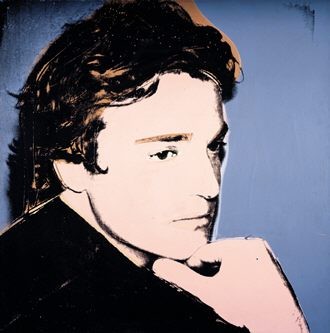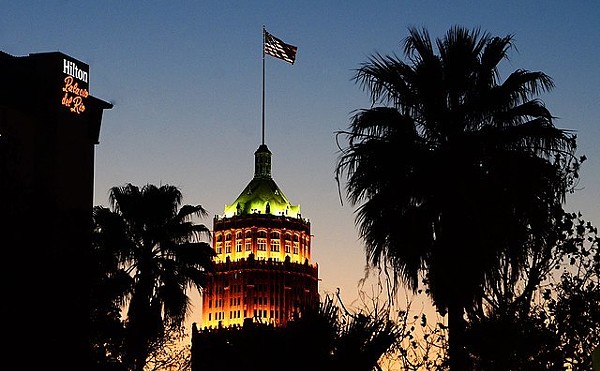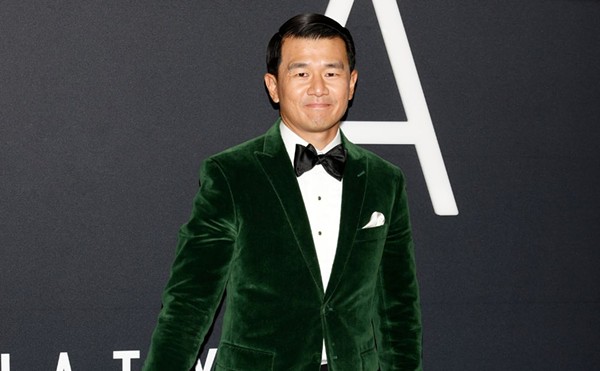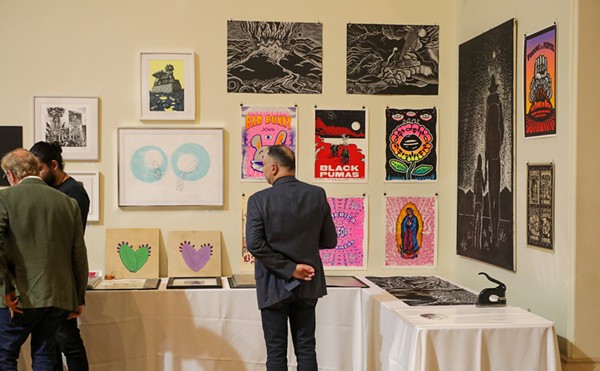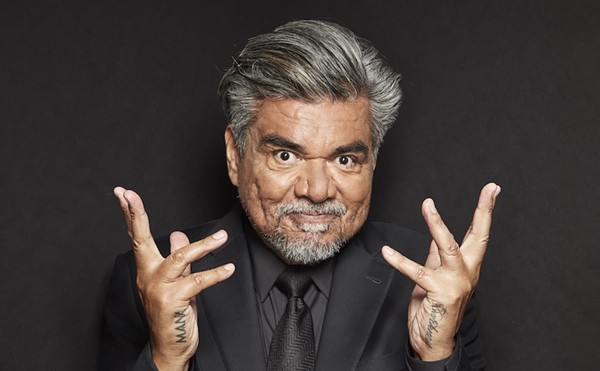| Factory Work 10am-4pm Tue-Fri, 10am-9pm Thu, 10am-5pm Sat, noon-5pm Sun Jan 17-Apr 8 $5 suggested donation Jamie Wyeth and Robert Rosenblum 6:30pm Thu, Jan 18 $5 suggested donation McNay Art Museum 6000 N. New Braunfels 824-5368 Mcnayart.org |
Jamie Wyeth: Realist standard-bearer.
Jean-Michel Basquiat: Street-smart graffiti artist.
Kindred spirits? You wouldn’t think so. But that didn’t stop Warhol and Wyeth from painting each other’s portraits and influencing each other, or keep Warhol and Basquiat from trying to profit, artistically and otherwise, from collaborative efforts.
Despite their collaborations, however, the word “mentor” doesn’t seem to fit Warhol’s relationship with either Wyeth or Basquiat. Both had achieved success before they produced art in Warhol’s Factory in the late ’70s and ’80s, and neither could accurately be described as Warhol’s Pop-art protégé.
| Warhol immortalizes Factory workers: “Self Portrait with Skull,” 1978. |
“These are three very different artists, with very different approaches in their work, and the way their art is made,” says René Paul Barilleaux, the McNay’s chief curator and curator of art after 1945, of Factory Work: Warhol, Wyeth, Basquiat.
The show, Barilleaux says, has two basic parts: Warhol and Wyeth, and Warhol and Basquiat. Each includes works by the younger artists before they met Warhol, works done in collaboration with him or under his influence, and tributes to Warhol after his death in February 1987.
In all, there are 75 paintings, drawings, photographs, and related artifacts, including Warhol-inspired “time capsules” — cardboard boxes of press clippings and other ephemera — devoted to Wyeth and Basquiat.
They come to San Antonio from an exhibition last fall at the Brandywine River Museum in Chadds Ford, Pennsylvania, and they’ll appear at the Farnsworth Art Museum in Rockport, Maine, from May 5 through August 26. (Both museums are near Wyeth family homesteads.)
| “Jean-Michel Basquiat,” 1982. |
This isn’t the first exhibition linking Jamie Wyeth to Warhol, notes guest curator and art historian Joyce Hill Stoner. The artists displayed portraits of each other in a two-man exhibition at New York’s Coe Kerr Gallery in 1976.
Wyeth, who is scheduled to speak at the McNay with art historian and critic Robert Rosenblum January 18, wanted to include Basquiat this time around. (Basquiat succumbed to heroin in 1988, less than two years after Warhol’s death.)
Half Puerto Rican, half Haitian, and all fire and fury, Basquiat slashed his way to the top of New York’s art scene and sought Warhol’s help, not so much with his painting, but with his “star-making strategies,” according to Margaret Rose Vendryes, author of the exhibition-catalog essay “Tagging Andy Warhol.”
Basquiat posed for Warhol in a jock strap, added hot hip-hop flourishes to Warhol’s cool canvases, and got slammed by Warhol’s improbable left hook on posters done up to look like a championship fight among heavyweights.
| “Portrait of James Wyeth,” 1976. |
From a distance, then, it would seem that Warhol’s Factory nickname, “Drella,” would apply perfectly to his relationship with Basquiat. Here was Warhol, the pale, older artist, half Dracula, half Cinderella’s fairy godmother, feeding off the creative life-force of younger artists, even as he helped their dreams of celebrity come true.
But before he died, Basquiat left behind “Gravestone,” a tribute to Warhol that will dispel any notion that the two artists were merely interested in exploiting each other. The three hinged wood panels of “Gravestone” pair a vivid yellow cross with a black rose and superimpose a dripping red heart with a skull. It’s far from sentimental, but it’s a moving and heartfelt work.
Wyeth and Warhol also seemed to share a true friendship and respect for each other, even if Wyeth’s “big, juicy oils” had no affinity at all with the mass-produced feel of Warhol’s Pop art, according to Stoner. In her catalog essay, Stoner quotes Wyeth: “Our work was diametrically opposite. But I loved the idea that he was a recorder … it fit right into what I wanted to do. And then I selfishly wanted to record him and paint every pimple that he had on his face. And he let me.”
Warhol, meanwhile, “glamorized Wyeth’s already-handsome features,” giving the younger artist the look of a matinee idol. The contrast was stark enough for critic Hilton Kramer to dub the 1976 Coe Kerr Gallery show an “all male version of Beauty and the Beast.”
Warhol seemed amused by Wyeth’s brutal portrayal of him as he stood in the Factory, holding his dachshund, Archie. Asked if he had any complaints, Warhol replied, “Yes, he made Archie’s nose too small.”
Warhol also graciously took some shots from Basquiat, whose 1982 “Head of Madman” makes Wyeth’s warts-and-all portrait seem attractive. Basquiat’s portrait partially exposes the skull from beneath the madman’s rotting face.
Warhol might appear to have tried to get even with his “piss painting” portrait of Basquiat, made from acrylic, silkscreen ink, and urine on canvas. But then again, Warhol, the avid antique collector, loved the unexpected patinas that would emerge on metallic objets d’arte over time. And he was well versed in how uric acids can accelerate the oxidation process when applied directly to metallic-based paints.
Besides, Warhol would never confront anyone to correct any misconception they had about him. If someone decided to attack him or his art, his instinct was to hide, ignore the assault, or even encourage it. A telling episode earlier in Warhol’s Factory career is when a visitor felt inspired to shoot a stack of his Marilyn paintings. Warhol calmly told her to do it, just because it seemed kind of cool. (Maybe he knew that the “Shot Marilyn” canvases would become even more famous, and shoot up in value overnight.)
Warhol and Basquiat collaborated on several works of art, and these are probably the most disappointing pieces in the show. Warhol would provide the initial image, and Basquiat would attack it and sometimes obliterate it. Basquiat’s solo pieces, such as his 1984 “Gold Griot,” influenced by Warhol’s 1962 “Gold Marilyn Monroe,” has more aesthetic balance.
Warhol and Wyeth only collaborated on a single painting, of a large pink pig (done for charity, and now believed to be destroyed). But their mutual influence is unmistakable, and will be readily evident to anyone who visits the McNay. Visitors who think they know Warhol and Wyeth as complete opposites will be amazed at the Pop sensibility that is clearly evident in Wyeth’s 1981 works “10 W 30” and “30 Dozen.” Wyeth depicts chickens nestled in corrugated boxes, with a heavy emphasis on the surface graphics printed on the outside of each box.
By focusing solely on Warhol’s relationships with Wyeth and Basquiat, the exhibition runs the risk of exaggerating the importance of these two artists in Warhol’s life. Never the life of the party, but often the host, Warhol cultivated a collection of acquaintances that included everyone from Mick Jagger (Warhol is credited with the Stones’ Sticky Fingers album cover) to Jackie Onassis, from Lou Reed to Jimmy Carter, from Truman Capote to Arnold Schwartzenegger, from Bob Dylan to Dolly Parton, and the list goes on and on.
Ultimately, that’s what Warhol was: a collector. He was obsessed with preserving his daily experiences, and he used tape recorders, Polaroid cameras, movie cameras, and video cameras to capture images, words, thoughts and ideas. The Andy Warhol Museum in Pittsburgh, Pennsylvania, the artist’s home town, has more than 8,000 cubic feet of material, including press clippings, posters, photos, fan mail, and other correspondence, and more than 600 “time capsules” that Stoner says the artist used to manage his accumulated flood of ephemera:
“He would be sitting at his desk, and just push everything on it into a cardboard box.”



